Lichtenberger Engineering Library
Friday, April 13th
2:00 PM – 4:00 PM
Join us to watch books come alive as researchers stand in for books. Take this opportunity to talk one-on-one with Engineers about their inspiring research!
Nicole Becklinger Amina Grant Jacob Herrmann Benjamin King
Rachel Marek Jaqueline Pereira da Silva Michael Rendleman Yusuf Sermet
Nicole Becklinger
Department of Mechanical and Industrial Engineering
Researching Methods for Reporting Agricultural Injuries and Near-Misses to Improve Farmers Safety
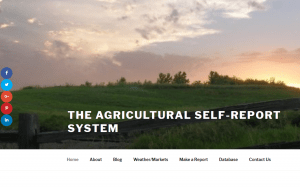
My research is to design and test an online self-report system for agricultural injuries and near-misses. The online self-report system is intended to address a lack of detailed information about farming injuries and to distribute safety and health information in a way that is convenient for farmers. The project is nearing the end of the development phase. I have created a working draft of the website and self-report survey. I’m having farmers and safety and health professionals review the system and am using their feedback to improve the design. This is an interdisciplinary project. The website design includes concepts from human factors engineering, systems engineering, and database management. I’m applying these concepts to a problem in agricultural safety and health, and ag safety and health principals are incorporated into my study. When the development phase is completed, I will be using traditional and viral web marketing techniques from business to promote the self-report system. This project has been a unique challenge and I look forward to sharing it!
Amina Grant
Department of Civil & Environmental Engineering
 Researching Lead and Copper in Iowa Drinking Water
Researching Lead and Copper in Iowa Drinking Water
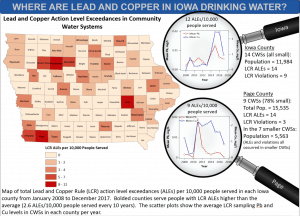
Since the Flint, Michigan, water crisis, public attention to the health effects of lead (Pb) and copper (Cu) in drinking water has increased. Unlike large water systems, small and medium-sized water systems are not required to provide corrosion control treatment under the U.S. EPA’s Lead and Copper Rule (LCR). About 93% of Iowa’s public water systems are either small or very small water systems. Corrosion control treatment (CCT) is only required in these smaller systems if the action levels for Pb and Cu are exceeded. The lack of continuous CCT endangers the public health of consumers in these communities. Several water quality parameters, such as high chloride levels, low pH levels, high nitrate in pipes, household piping materials, type of water source, and treatment methods, are suspected to contribute to elevated concentrations of Pb and Cu. To explore potential causes of elevated concentrations of Pb and Cu, I am analyzing available Pb and Cu data for small community water systems in Iowa to identify 20 small communities to survey and measure Pb and Cu, water quality parameters, and treatment methods used. The overall objective is to investigate the issue of Pb and Cu in small community drinking water systems in Iowa. The overarching goal is to provide a publicly accessible database as well as evaluate potential causes of elevated concentrations of Pb and Cu in Iowa drinking water. This data website will also be a site where the public can learn how to test and report their water quality effectively, understand the different water reports released to them, and become educated on different water issues impacting them on a local, national, and global scale.
Jacob Herrmann
Department of Biomedical Engineering
 Researching Optimal Protective Ventilation to Treat Severe Lung Injury
Researching Optimal Protective Ventilation to Treat Severe Lung Injury
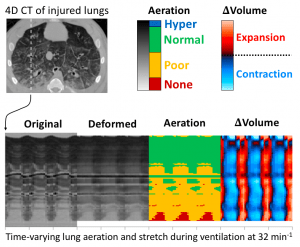
Mechanical ventilation is a life-sustaining intervention for critically ill patients who have difficulty maintaining oxygenation, but great care must be taken to avoid further harm by over-stretching or collapsing the already-injured lungs. My research involves designing, testing, and optimizing techniques for safely and effectively ventilating injured lungs. In particular, we have focused on manipulating how respiratory rate or frequency affects the heterogeneous distribution of lung tissue stretch and gas exchange. This project includes applications of biological tissue mechanics and physiology, fluid mechanics and gas transport, medical imaging, signal processing, and computational simulation.
Benjamin King
Department of Chemical & Biochemical Engineering
 Researching the Development of Aerosols for Targeted Drug Delivery in the Lungs
Researching the Development of Aerosols for Targeted Drug Delivery in the Lungs
I designed and synthesized polymer-coated gold nanoparticles functionalized for targeted delivery in the lungs. I collaborated on a variety of projects, including toxicity studies of environmental aerosols, investigating susceptibility to bacterial infection as a result of industrial nanoparticle exposure (a GPCR-dependent process), and the development of spray-dried antibiotic formulations for inhaled therapies. In my work I supervised and managed the projects of 11 undergraduate researchers, curated the lab’s digital chemical inventory, maintained safety training and documentation for all lab personnel, and developed the Bloodborne Pathogen Plan.
Rachel F. Marek
IIHR-Hydroscience and Engineering

Researching Human Exposure to Persistent Organic Pollutants like PCBs, Pesticides, and Siloxanes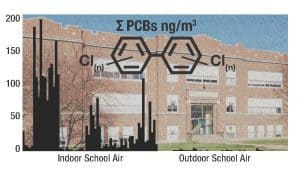
I have an undergraduate degree in chemistry and graduate degrees in environmental engineering. My research involves analysis of PCBs, their breakdown products, and other environmental contaminants such as siloxanes and pesticides in sediment, air, and human serum. I am interested in whether people, especially children, are exposed to harmful chemicals. I have been part of the Iowa Superfund Research Program (isrp) since 2007 and am a contributor to four different isrp Projects and the Analytical Core with a focus on identifying PCBs and their breakdown products in complex environmental and biological matrices. My efforts outside the isrp include collaborations on passive air monitoring of pesticides at farm houses, lab experiments with siloxanes, and novel instrument applications for monitoring environmental contaminants. My expertise is in project management involving environmental sampling and wet and analytical chemistry, including method development. I have broad interests in sustainability, contaminant research, and policy applications.
Jaqueline Pereira da Silva
Department of Mechanical & Industrial Engineering
Researching Human Factors Engineering for the Prevention and Control of Healthcare-Associated Infections
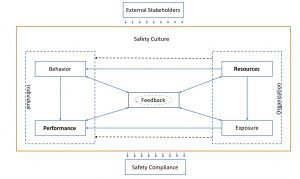
Healthcare-associated infections (HAIs) are acquired by patients undergoing medical care in a hospital or healthcare establishment. Both the Centers for Disease Control and Prevention (CDC) and the World Health Organization (WHO) have been emphasizing the major risks associated with HAIs and best practices to prevent them from happening. However, compliance among healthcare professionals regarding infection prevention and control (IPC) is still suboptimal. The difficulty pinpointing the origin of an infection, coupled with the fact that microbes cannot be seen with the naked eye, pose additional cognitive challenges in the development of IPC measures as these two determinants affect perceived risk factors. The adversity that the healthcare community faces regarding HAIs can and should be mitigated with the help of human factors engineering (HFE) principles. HFE focuses on people’s cognitive and physical abilities and restraints, seeking to adapt the environment and systems to best fit these characteristics and to optimize performance.
My research explores the field of IPC with an HFE perspective. More specifically, it aims at identifying risk factors and challenges inherent to typical healthcare settings in order to develop a model that would promote sustainable outcomes and in turn contribute to the success of healthcare professionals when complying with IPC measures.
Michael Rendleman
Department of Electrical & Computer Engineering
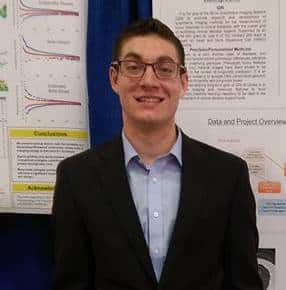
Researching Cancer Outcome Prediction with Machine Learning and Genomics
Tumor characterization is an integral part of personalized oncological medicine. Machine learning has been previously applied to this topic in the context of cancer imaging and radiomics, yielding results showing significant association with gene expression in lung cancer patients. In my research, I apply machine learning algorithms and techniques to publicly-available clinical data to infer missing values and to predict positive patient outcomes. The data we utilize are sourced from The Cancer Genome Atlas Head and Neck Squamous Cell Carcinoma (TCGA-HNSC) dataset. Working with large multi-institutional datasets can present a number of technical challenges, so computational preprocessing and model parameter tuning are important steps for making the most of the available data.
The predictive models we build and train will serve as a baseline for future tumor characterization using a combination of a patient’s clinical, imaging, and genetic information. Our approach will ultimately provide a novel path for clinical decision support and ultimately more informed, precise oncological treatment in the age of personalized/precision genomic medicine.
Yusuf Sermet
Department of Electrical & Computer Engineering

Researching Artificial Intelligence and Virtual & Augmented Reality to Facilitate Environmental Research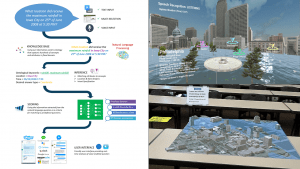
My research focuses broadly on the application of contemporary topics in computer science and engineering, including artificial intelligence (AI), natural language processing (NLP), big data science, data mining, scientific visualization, citizen science, camera-based sensors, augmented & virtual reality, GPGPU, and web-based development.
One of the recent projects I have worked on is the Flood Expert, an intelligent system designed to improve societal preparedness for flooding by providing a knowledge engine that uses voice recognition, AI, and NLP. The knowledge engine uses flood ontology to connect user input to relevant knowledge discovery channels on flooding using environmental observations, forecast models, and knowledge bases. The interaction and delivery channels include voice and text input via web-based systems, agent-based chat bots (e.g., MS Skype, Facebook Messenger), smartphone and augmented reality applications (e.g., Google Now, MS Cortana, MS HoloLens), automated web workflows (e.g., IFTTT), and smart home devices (e.g., Google Home, Amazon Echo). Alongside Flood AI’s potential to assist the public, decision-makers, and authorities as they respond to disasters, the system also can raise public awareness to natural hazards.



